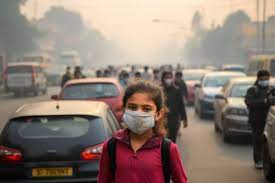Air Quality Alerts: Keeping Children Safe on High Pollution Days
- Admin
- 17-Nov-2023
Introduction
In Gurgaon, where the air we breathe is a matter of concern, especially for our children, understanding the Air Quality Index (AQI) and monitoring air pollution level becomes crucial. As parents and educators, we bear the responsibility of safeguarding their well-being. This blog delves into the significance of the AQI, current air pollution levels, and the specific challenges posed by air pollution in Gurgaon. Join us as we explore ways to ensure our children's safety on days when air quality is compromised.
Table of Contents:
1. Understanding Air Quality Alerts
2. Effects of Poor Air Quality on Children
3. Protecting Children on High Pollution Days
1. Understanding Air Quality Alerts

Air quality alerts are vital tools that provide information about the quality of the air in a specific location. These alerts are issued by environmental agencies and organizations to warn individuals about potential health risks associated with poor air quality. They rely on the Air Quality Index (AQI), a standardized system that considers various air pollutants, including particulate matter (PM2.5 and PM10), ground-level ozone, carbon monoxide, sulfur dioxide, and nitrogen dioxide.
The AQI categorizes air quality on a scale from "Good" to "Hazardous." The higher the AQI value, the worse the air quality. To help individuals quickly assess the situation, different colors and descriptions are used to represent these categories.
2. Effects of Poor Air Quality on Children

Children are more vulnerable to the effects of air pollution for several reasons:
1. Developing respiratory systems: Children's respiratory systems are still developing, making them more susceptible to respiratory issues caused by pollution.
2. Increased breathing rate: Children breathe more rapidly than adults, leading to greater exposure to pollutants.
3. Outdoor play: Children spend more time outdoors, increasing their exposure to outdoor air pollutants.
4. Immature immune systems: Immature immune systems make children less capable of dealing with the health impacts of poor air quality.
Poor air quality can lead to various health problems in children, such as:
1. Asthma: Aggravation of existing asthma and increased risk of developing it.
2. Respiratory infections: Increased likelihood of respiratory infections like bronchitis and pneumonia.
3. Cognitive development: Impaired cognitive development due to exposure to neurotoxic air pollutants.
4. Allergies: Higher risk of developing allergies, as air pollutants can trigger allergic reactions.
3. Protecting Children on High Pollution Days

Now that we understand the significance of air quality alerts and the potential health risks, let's explore strategies to safeguard our children's health on high pollution days:
1. Stay Informed: Stay updated with air quality alerts in your area. Numerous websites and apps provide real-time air quality data. Pay close attention to color-coded AQI levels, and on days with poor air quality, avoid outdoor activities.
2. Create a Safe Indoor Environment: Keep windows and doors closed during high pollution days to prevent outdoor pollutants from entering your home. Consider using air purifiers equipped with HEPA filters to reduce indoor air pollutants.
3. Limit Outdoor Activities: Encourage your children to engage in indoor activities, such as reading, playing board games, or attending indoor events on days when air quality is poor. If your child is involved in sports, ensure they practice in well-ventilated indoor spaces like gyms.
4. Use Masks: If your child must be outdoors on high pollution days, consider using N95 masks to reduce their exposure to harmful pollutants. These masks can help filter out fine particles and provide an extra layer of protection.
5. Teach Good Hygiene: Encourage your children to wash their hands and face after being outside. This simple practice can help remove pollutants they may have picked up while playing or traveling through polluted areas.
6. Healthy Diet: Consider incorporating a diet rich in antioxidants for your children. Fruits and vegetables high in vitamins C and E can help mitigate the effects of pollution on their health.
7. Stay Hydrated: Proper hydration is essential, as it helps the body expel toxins more efficiently. Ensure your child drinks an adequate amount of water, especially on high pollution days.
8. Reduce Car Travel: If possible, use public transport, carpool, or opt for non-polluting alternatives like walking or cycling on high pollution days. This reduces your child's exposure to vehicular emissions.
Conclusion
Air quality alerts are invaluable tools for safeguarding our children's health on high pollution days. By understanding the significance of these alerts and taking appropriate measures, we can protect our children from the adverse effects of poor air quality. Remember, a proactive approach to air quality management ensures that our children can continue to breathe clean, healthy air and thrive.
Discover excellence in education at Mount Olympus School
Best School in Gurugram

Related Blogs
- Beyond Textbooks: Innovative Teaching Methods at Mount Olympus School
- Global Outlook, Local Roots: The Advantages of an International Education at Mount Olympus School
- Importance of Preschool Reading: Components, Books and More
- What are the Appropriate School Activities for Preschoolers?
- A Deep Dive into the 10 Best Active Learning Strategies at Mount Olympus School
- Air Quality Alerts: Keeping Children Safe on High Pollution Days
- The Impact of Air Pollution on Education in Gurugram
- How to Choose the Best Pre-Primary School for Your Child
- How to Choose the Best CBSE School for Your Child
- Exploring the State-of-the-Art Infrastructure at Mount Olympus School in Sector 79, Gurgaon
- Building Strong Foundations: The Importance of Preschool Education in Gurgaon
- Choosing the Best Preschool in Gurgaon: A Guide for Parents
- Unlocking Excellence: The Journey of Mount Olympus School, the Best School in Gurgaon
- How Mount Olympus Juniors School in Sector 57, Gurugram Nurtures Young Minds
- Promoting a Happy and Safe Learning Environment Mount Olympus School in Gurgaon
- Discover the Exemplary Pre-Nursery Education at Mount Olympus School, Gurgaon
- Parents tend to switch schools in July: solution Mount Olympus School, sector 79
- Career Guidance: Choose the Right Career for Happiness in Life
- Parents are a Childs best Friend
- Should children be allowed to dream?
- Self Improvement By Harshit Chawla VII
- Mosmun 2.0
- Why it is Important to teach your children about self love?
- Why Co-scholastic activities are important in a students life?
- How to Choose a School for your child?
- Why Discipline is Important in a Students Life?
- Best Dussehra Celebrations
- MOS Ki Diwali
- Gurpurab
- Vaccination Drive For Students
- Should I praise my child?
- Significance of Primary Education
- Fostering Self Esteem in the Child
- Rocksport Adventure Camp
- Preparing your child for school
- Parenting
